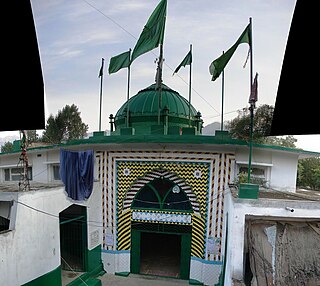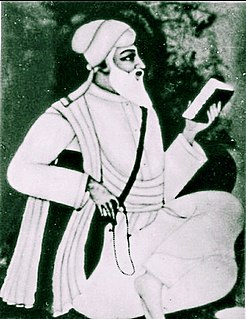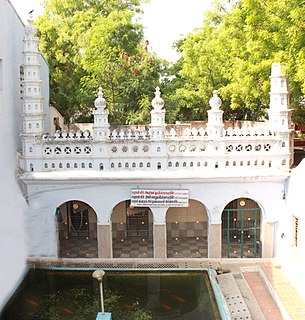
Muhammad Nizamuddin Auliya, also known as Hazrat Nizamuddin, and Mahbub-e-Ilahi was an Indian Sunni Muslim scholar, Sufi saint of the Chishti Order, and is one of the most famous Sufis from the Indian Subcontinent. His predecessors were Fariduddin Ganjshakar, Qutbuddin Bakhtiyar Kaki, and Moinuddin Chishti, who were the masters of the Chishti spiritual chain or silsila in the Indian subcontinent.

A dargah is a shrine built over the grave of a revered religious figure, often a Sufi saint or dervish. Sufis often visit the shrine for ziyarat, a term associated with religious visits and “pilgrimages”. Dargahs are often associated with Sufi eating and meeting rooms and hostels, called khanqah or hospices. They usually include a mosque, meeting rooms, Islamic religious schools (madrassas), residences for a teacher or caretaker, hospitals, and other buildings for community purposes.

The Suhrawardiyya is a Sufi order founded by the Sufi Diya al-din Abu 'n-Najib as-Suhrawardi. It is a strictly Sunni order, and, like many such orders, traces its spiritual genealogy (silsila) to Ali ibn Abi Talib through Junayd Baghdadi and al-Ghazali. It played an important role in the formation of a conservative ‘new piety’ and in the regulation of urban vocational and other groups, such as trades-guilds and youth clubs, particularly in Baghdad.

Nizamuddin Dargah is the dargah (mausoleum) of the Sufi saint Khwaja Nizamuddin Auliya. Situated in the Nizamuddin West area of Delhi, the dargah is visited by thousands of pilgrims every week. The site is also known for its evening qawwali devotional music sessions. The descendants of Nizamuddin Auliya look after the whole management of dargah Sharif.

Urs or Urus, is the death anniversary of a Sufi saint, usually held at the saint's dargah. In most Sufi orders such as Naqshbandiyyah, Suhrawardiyya, Chishtiyya, Qadiriyya, Bukhari, etc. the concept of Urs exists and is celebrated with enthusiasm. The devotees refer to their saints as lovers of God, the beloved.

Nasiruddin Mahmud Chirag-Dehlavi was a 14th-century mystic-poet and a Sufi saint of the Chishti Order. He was a disciple of Sufi saint Nizamuddin Auliya, and later his successor. He was the last important Sufi of the Chishti Order from Delhi.
The Baba Budangiri shrine is shrine named after the Sufi saint Baba Budan, who is revered by both Muslims and Hindus. Its origin appears to be a syncretization of reverence for an 11th-century Sufi, Dada Hayath ; for the 17th-century Sufi Baba Budan, said to have brought coffee to India; and for Dattatreya, an incarnation of Shiva. It has been controversial due to political and religious tension over its status as a syncretic shrine.

Sayyid Ali Tirmizi, more commonly known as Pir Baba, was a Sufi who settled in Buner among the Yusufzai Pashtuns. He was probably born in 908 AH, in Fergana, of Sayyid descent, died in AH 991. He was a supporter of the Mughal emperor Babar, and was an opponent of Bayazid Pir Roshan.https://en.m.wikipedia.org/wiki/File:Pir_Baba_Buner.jpg

Jalaluddin "Surkh-Posh" Bukhari was a Sufi saint and missionary belonging to the Sufi order of Hussaini jalali.

Hashim peer Dastagir was an Indian Sufi saint according to the tradition of the Qadri Shattari Sufi order. His shrine is in Bijapur, Karnataka, India.

Madurai Maqbara refers to the Dargahs of three Sufi saints: Mir Ahmad Ibrahim, Mir Amjad Ibrahim, and Abdus Salaam Ibrahim situated in Kazimar Big Mosque, Madurai, India.
The Meerasaheb dargah of Hazarat sayyad Khawaja Muhammadmira hussaini chishti shamsul ushaq and his son Shahide akbar Hazarat sayyad Khwaja Shamsuddin al ma-ruf shamnamira ganj baksh chishti r.a. is a common worship centre for both Muslim and Hindu communities located near the railway station of Miraj. Meerasahab is from the Chishti Sufi spiritual order.
Khwaja Ghareeb Nawaz Hazrat Mawlana Pir Fazal Ali Shah Qureshi was an Islamic scholar and the leading Naqshbandi Shaikh of colonial India in the early twentieth century. He was born to Murad Ali Shah in 1270 AH in Daud Khel, Punjab, and died at 84 in the first night of Ramadan 1354 AH and was buried at Miskeenpur shareef, district Muzaffargarh, Punjab.

Ajmer Sharif Dargah, Ajmer Dargah, Ajmer Sharif or Dargah Sharif is a Sufi shrine (dargah) of the revered Sufi saint, Moinuddin Chishti, located at Ajmer, Rajasthan, India. The shrine has Chishti's grave (Maqbara).

Syed Mohammad Baba Tajuddin, also known as Tajuddin Baba, was an Indian Sufi Master whose followers considered the last Mujaddid and Qutb. His shrine is in Nagpur, India.

Bareilly Sharif Dargah or Dargah-e-Aala Hazrat is a Dargah (tomb) or monument of Ahmed Raza Khan located in Bareilly city in the state of Uttar Pradesh, India. He was a 19th-century Ahle Sunnat, who is known for his staunch opposition of Wahhabis in India. The dome of the Dargah was designed by Shah Mehmood Jaan Qadri with the use of matchsticks

Syed Mohammed Mukhtar Ashraf (Urdu: سید محمد مجطر اشرُف, Hindi: सैयद मोहम्मद मुख्तार अशरफ़) well known as Sarkar E Kalan or Shaikh ul Mashaikh was an Indian Sufi saint, spiritual leader, Islamic Scholar of Ahle Sunnah of the Ashrafi sufi order from Ashrafpur Kichhauchha, Uttar Pradesh, India. He was a relative of Sajjada nashin of Dargah Ashraf Jahangir Semnani, founder of the Ashrafi Sufi Order. Syed died on 21 November 1996 in Ashrafpur Kichhauchha and was buried near dargah of Ashraf Jahangir Semnani.

Khwaja Hasan Sani Nizami was a Sufi Shaykh of Nizami branch of Chishti Order and the former Sajjadanasheen of Nizamuddin Auliya's shrine and considered as the most prominent figure of Urdu literature. He was a member of United Nations Religious Initiatives, San Francisco of United States of America. He was the son of Khwaja Hasan Nizami and the master of Iqbal Ahmad Khan.

Hazrat Baba Haji Sher Dewan is a shrine to Haji Sher Muhammad Dewan, a preacher of Islam in the Punjab area. It is located in a village near Burewala, Pakistan, 125 km from Multan and 73 km from Pakpatan Shareef.
















